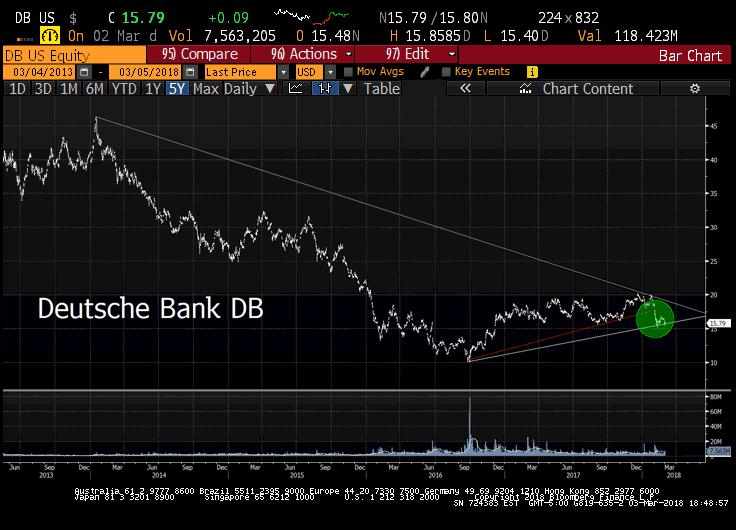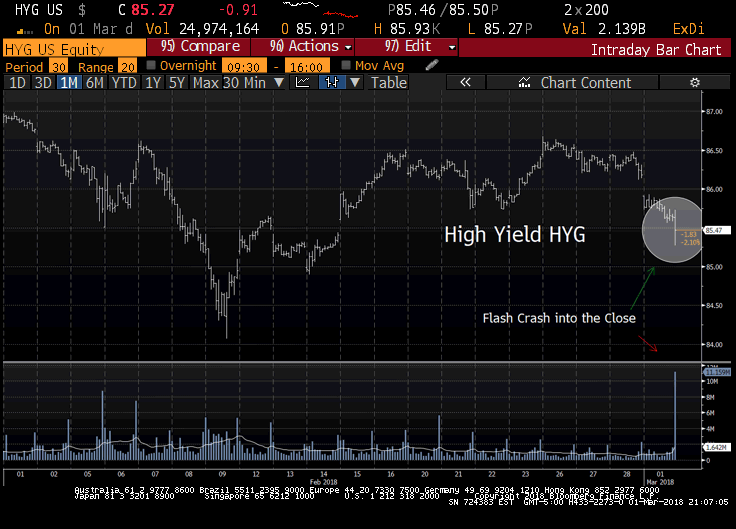Join our Larry McDonald on CNBC’s Trading Nation, Wednesday at 3:05pm ET
Pick up our latest report here:
Don’t miss our next trade idea. Get on the Bear Traps Report Today, click hereLucy and the Football
Heading into Fed meetings, each time public “Fedspeak” (governors on the speaking tour) raise the hawkish bar (expectations for a more aggressive policy path – rate hikes). In every instance, Wall Street gets drawn in, gold heads into capitulation. Next, the “dovish hike” (below sky-high expectations) triggers the gold rally. Rinse and Repeat.
Gold Miner’s $GDX Returns after Fed Rate Hikes
Mar 2018: +5% (so far)
Dec 2017: +17%
Jun 2017: +17%
Mar 2017: +18%
Dec 2016: +36%
Dec 2015: +136%
Bloomberg data
Hook, Line, and Sinker
Each and every time the Fed has hiked rates, their effort to signal the hike has been well over-cooked. In an effort to provide transparency they’ve consistently oversold rate hikes. Wall St. (sell-side economists) take the sales pitch hook, line, and sinker. It’s “Lucy and the Football” over, and over and over again. Heading into the Fed meetings, very consistently, the hawkish song (threats of pulling away accommodation) from the Fed has punished gold, only to see a beautiful relief rally each time.
Managing and Measuring the Street’s Expectations is the Key
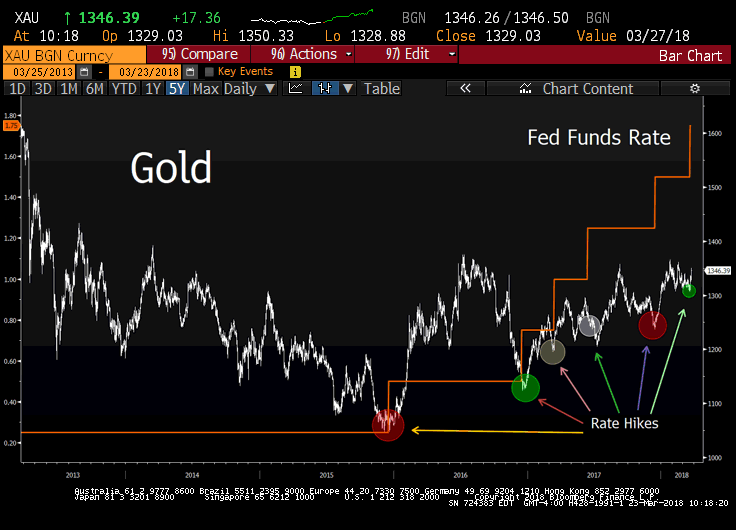
The Federal Reserve has been gold’s best friend. Heading into (rate hike) Fed meetings, each time the public “Fedspeak” (governors on the speaking tour) raises the hawkish bar (expectations for a more aggressive policy path – rate hikes). In every instance, the Wall Street gets drawn in, gold heads into capitulation. Next, the “dovish hike” (Fed delivering well below sky-high expectations) triggers the gold rally. Each round of expectations out of balance has led to higher gold (and gold miner’s) price action in the weeks after rate hikes.
Since last week’s Fed Meeting, the probability of a June rate hike has plunged, from 90% to near 73% – while gold has surged from $1307 to $1350. When you’re trading gold, you’re actually trading eurodollars, the Fed rate hike expectations curve.
Gold Silver Cross, Speaks to a Global Economic Recession
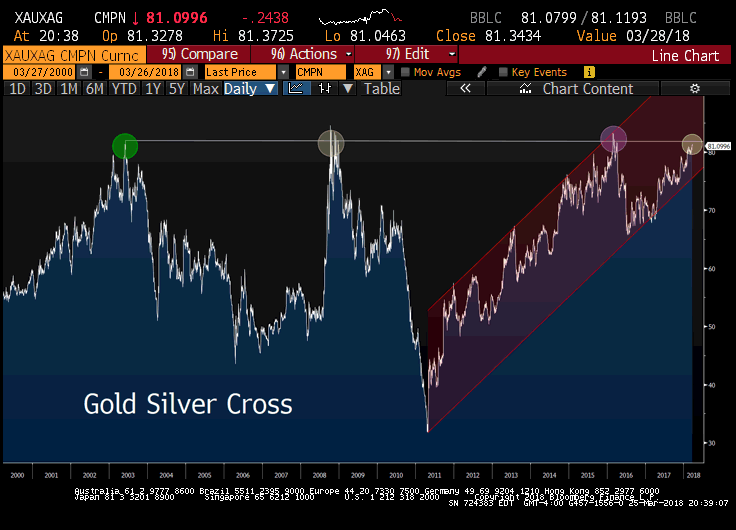
The divergence between the two means prices for gold are 82 times those of silver, which is 27% more than the 10-year average and the highest level in two years, data analyzed by WSJ Market Data Group show. A higher gold-to-silver ratio is viewed by some investors as a negative economic indicator because money managers tend to favor gold when they think markets might turn rocky and discard silver when they are worried about slower global growth crimping consumption. Industrial uses account for about 55% of demand for silver, according to the Silver Institute, leading some traders to link it more with base metals like copper and others.
China Warning
The precious metals ratio last stayed above 80 in early 2016, when worries about a Chinese economic slowdown roiled markets, and in 2008 during the financial crisis. The ratio’s recent rise comes as speculators have turned bearish on silver and inventories in warehouses have risen, a sign there could be too much supply.
COT Data, Bullish
Our friend Jordan Roy Byrne notes net speculative positioning in Silver (against Open Interest) hit 1.7% this week, the lowest on record. To us, this is more than BULLISH. Friday’s commitment of traders (COT) report showed speculators shifted aggressively net short, something NOT seen every day, and commercials are almost in balance, which is also unusual and bullish in our view.
MSCI World Equities vs. the Gold Silver Cross
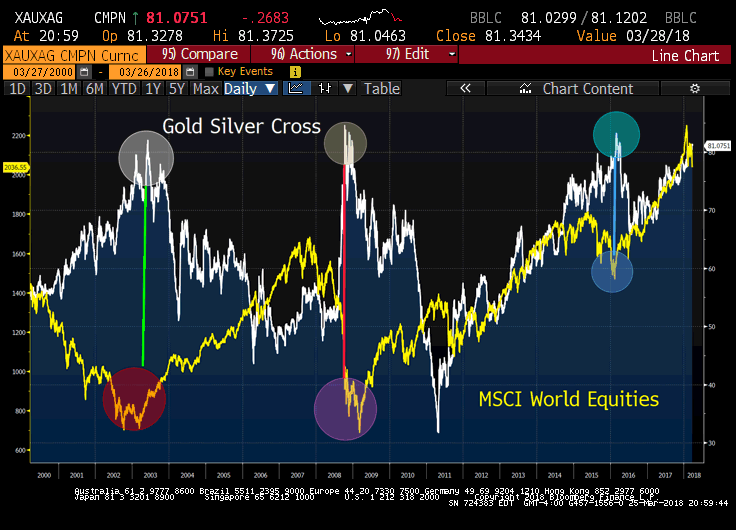 This is a bit of a mindblower. Over the last twenty plus years highs in the gold-silver cross (extremely weak silver pricing relative to gold) were met with bear markets in global equities. Which makes a lot of sense, for decades silver has been a global economic bellwether. In the 2017-18 global equities, paradigm stocks have climbed even as silver has dramatically cheapened. To us this speaks to deleveraging in China, industrial metals are pricing in some pain, a lookout warning for the global economy (and equities). Pick up our full report here.
This is a bit of a mindblower. Over the last twenty plus years highs in the gold-silver cross (extremely weak silver pricing relative to gold) were met with bear markets in global equities. Which makes a lot of sense, for decades silver has been a global economic bellwether. In the 2017-18 global equities, paradigm stocks have climbed even as silver has dramatically cheapened. To us this speaks to deleveraging in China, industrial metals are pricing in some pain, a lookout warning for the global economy (and equities). Pick up our full report here.
Must Read from the WSJ on Silver, well done.
Pick up our latest report here:
Don’t miss our next trade idea. Get on the Bear Traps Report Today, click here
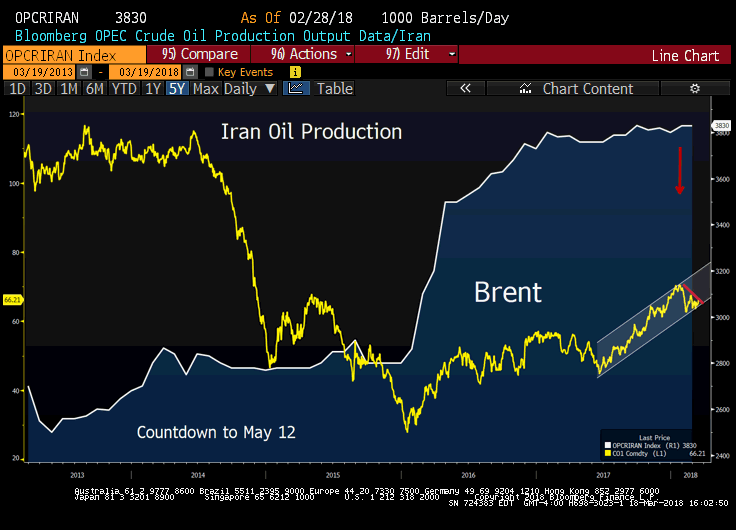 Oil bulls have their minds on 2012. As the U.S. launched touch sanctions with a bullseye focused on Iran’s oil industry. Exports plunged by over one million barrels a day. As we look toward the May 12 deadline on the Obama era Iran deal, a repeat of the drama six years ago would DOUBLE the expected supply deficit in the second half of this year.
Oil bulls have their minds on 2012. As the U.S. launched touch sanctions with a bullseye focused on Iran’s oil industry. Exports plunged by over one million barrels a day. As we look toward the May 12 deadline on the Obama era Iran deal, a repeat of the drama six years ago would DOUBLE the expected supply deficit in the second half of this year. The surge in three-month libor matters because the entire ecosystem of U.S. short-term corporate finance is being repriced. The Street is finally waking up to credit risk tied to rising rates. In recent months we’ve warned, at the current pace of spending in Washington – a year from now we’re looking at quarterly Treasury auctions in the neighborhood of $23B – $26B for long bonds vs. $13-$15B now. But above all, we must keep our eye on short-term, adjustable rate corporate finance.
The surge in three-month libor matters because the entire ecosystem of U.S. short-term corporate finance is being repriced. The Street is finally waking up to credit risk tied to rising rates. In recent months we’ve warned, at the current pace of spending in Washington – a year from now we’re looking at quarterly Treasury auctions in the neighborhood of $23B – $26B for long bonds vs. $13-$15B now. But above all, we must keep our eye on short-term, adjustable rate corporate finance.